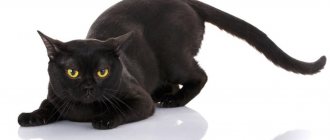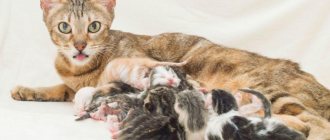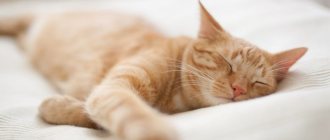Ragdoll appearance
The formation of an adult animal is completed by the age of 3. The Ragdoll has a long, muscular body with a tendency to be plump (mainly in the belly and groin area), a wedge-shaped head with a rounded muzzle, silky thick coat with a noticeable collar and “pants,” and a well-furred long tail.
Body
The elongated and muscular body is noticeably weighted at the back, while the chest is quite wide and developed, and the interval between the shoulders is equal to the width of the croup. Excess fat is often deposited on the abdomen, as well as in the groin folds. The neck is strong, short and muscular.
Head
The Ragdoll, unlike similar breeds (Siberian and Neva Masquerade), has a flat space between the ears.
The head is medium-sized, wedge-shaped, with pronounced cheeks leading into a well-developed muzzle with moderate jaws and chin. Breeding males often have more prominent cheeks. The length of the nose (with a slight break allowed) relates to its width in a ratio of 2:1.
Eyes
They have a large oval shape, located slightly obliquely and at a great distance from each other.
Ragdolls are only allowed blue eyes (the brighter the better).
Ears
Medium (with rounded tips), slightly directed forward and wide at the base. Hair grows on the inside of the ears; tassels on the tips of the ears are acceptable.
Limbs
Strong, with pronounced muscles. The back is raised towards the croup due to the fact that the hind legs are longer than the front ones. The large oval paws have fur visible between the toes.
Wool
Ragdoll hair should be semi-long or long (the latter is preferable), have a soft silky structure, and not tangle. The coat does not fit very tightly to the body and begins to move when the animal moves.
The hair on the front legs is shorter than on the hind legs, where it often folds into characteristic “pants.” More abundant fur is observed in cats living in northern regions. Ragdolls shed heavily in summer.
Colors
Ragdolls are recognized by all serious felinological organizations, which do not stop discussing only the “legitimate” breed colors. So far, the CFA and WCF are winning the color dispute, having determined 4 main colors for ragdolls - charcoal gray, lilac, blue and chocolate. European associations add red, tortoiseshell, cream and tabby colored animals to the list.
In general, ragdolls are allowed to have the following colors:
- color point – dark brown (seal), chocolate (chocolate), blue (blue) and lilac (lilac);
- color point with white (bi-color, mitted);
- red, cake point, cream;
- any variants of tabby point and all its combinations with white (mitted, bi-color).
There are 3 possible color classes for the Ragdoll breed.
Color point
Differs from the generally accepted color point color:
- The mask is present on the forehead, but does not extend beyond the middle of the ears;
- There is a small light area at the base of the ear. The neck, chin and chest area are always much lighter than the markings.
Mitted
The mask covers the forehead, cheeks, whisker pads, nose and eyes, without affecting the light area at the base of the ears. The chest, neck and chin remain white. The lower part of the neck is sometimes marked by a white line running between the forelegs through the belly to the root of the tail.
The body color becomes lighter from the back to the sides and belly. The front paws are decorated with identical white “gloves”. Where white fur grows, the skin has a pink tint. The hind legs are completely white, except for the area above the middle of the thigh. Only white hair is also allowed around the knee joint.
Bicolor
The coat is well colored. The color of the points (mask, ears and tail, with the exception of the "L" on the face) should stand out clearly. A light area remains at the base of the ears. On the muzzle, a symmetrical white triangle is allowed, “superimposed” on the nose, whisker pads, lips, chin and flowing into a white “frill”. The “L” symbol on the muzzle can reach the width of the outer corners of the eyes and must be strictly symmetrical. The chest, belly and four legs are painted white.
The back may be slightly lighter than the points, but not pure white. White and colored spots (of different configurations and sizes) are allowed on the back. The standard does not stipulate the ratio of pigments.
Ragdoll appearance
How lovely
Ragdolls impress not only with their beauty, but also with their size. Cats can reach a meter in length, and the largest of them weigh about 12 kg. Smaller cats - their weight is limited to 7 kg, length - up to 80 cm.
It happens that their closest relatives, Burmese cats, are mistaken for redgalls, since they are very similar in color. However, Ragdoll standards are decidedly different and strictly defined. Three classic color standards are allowed: colorpoint, mitted, bicolor. Each of them has 4 varieties: seal (dark brown), chocolate, blue, lilac.
Frame
The Ragdoll's body is long, muscular, and massive (especially in the rear). The chest is powerful, protruding forward, the neck is short, strong, the bone is wide. At the same time, muscle tone is reduced, so the animal’s body is relaxed. The abdomen may sag, usually after the age of eight.
Limbs
Medium length, strong. The hind limbs are slightly longer than the forelimbs. The feet are round, large, with tufts of hair between the toes on the pads.
Head
The head is quite massive, proportional, the chin is well developed. The muzzle with plump cheeks is pointed, the nose is of medium length.
Color point ragdoll
Ragdoll mitted color
Bi-color ragdoll
Eyes
Oval, large, wide open. Moderately widely spaced. The eyes are slightly slanted towards the bridge of the nose, which gives the cat's gaze some playfulness and a surprised look. A pronounced slant of the eyes, as well as their almond shape, are a defect in the breed. The ragdoll's eye color, depending on the lighting, is blue or bright blue.
Ears
Medium in size, wide at the base, rounded at the tips, which are sometimes decorated with tassels. The ears are slightly tilted forward.
Ragdoll face
Tail
The Ragdoll's tail is long, proportionate to the body, gradually tapering towards the tip. Densely covered with fur. A short, knobby tail is a breed defect.
Wool
Fluffy handsome man
Moderately long, thick, soft. The undercoat is minimal, so the fur does not tangle. On the forelimbs the hair is short and medium length, on the hind legs it is medium and medium-long. There is a thick collar around the neck. The length of the hair on the body increases from the shoulder blades to the tail.
By winter, the ragdoll's "fur coat" becomes even thicker. Animals living in cold climates have longer fur.
Color
Ragdoll kittens are born completely white, and only at the age of two they acquire a stable color. With age, the colors become deeper.
Colorpoint ragdolls have muzzles, ears, tails, and the lower part of their legs that are darker in color than the main, light part of the body. Noses and paw pads are in the same dark colors.
The mitted color also implies a combination of a dominant light coat color and dark fragments. At the same time, cats have white “socks” on their paws, a white stripe on their stomachs, and their chin and luxurious collar are painted the same color.
Bicolor ragdolls also have dark markings, but on the face the dark fur is combined with white, which runs between the eyes and grips the cheeks, forming a triangle. Cat paws are completely white. The nose and paw pads are pink. The “saddle” is painted dark.
Each color type may have its own colors. According to American standards, there are four of them:
Chocolate Ragdoll
- strength: base color – “light tan”, markings – dark brown;
- chocolate: dominant color – ivory, markings – milk chocolate;
- blue: main color – light gray, markings – dark gray;
- lilac: the main color is white, the markings are pinkish-gray.
The huge luxurious mustaches of ragdolls are always snow-white.
The description of the ragdoll includes the color and name of the coat. For example, force-colored cats are represented as seal colorpoint, seal mitted, and seal bicolor.
Some European felinological associations also recognize the following colors in the color of ragdolls: red, cream, tortoiseshell, tabby.
What are the features of keeping ragdolls?
The main feature of Ragdoll cats that should be taken into account when keeping them is their muscle relaxation. Because of this feature, ragdolls do not know how to group in the air, like cats of other breeds, and jumping is also difficult for them. Falling even from a small height (about 1 meter) can cause serious injury to pets, so you should not throw cats on the floor
In addition, children should be taught the importance of caring for animals.
It is also necessary to prepare the house: equip windows with anti-cat nets, remove dangerous substances and objects from the ragdoll’s access area, secure wires, purchase and place “cat” accessories, remove plants to an inaccessible height, and take other measures to ensure the comfort and safety of the pet.
The content should also take into account the vulnerability and sensitivity of cats of this breed. Swearing and screaming can make Ragdolls feel very sad. They also do not tolerate loneliness very well. Breeders say that a bored ragdoll seems to lose weight and waste away before our eyes. In addition, if they are left alone for a long time and often, their character may deteriorate.
Toys do not save ragdolls from loneliness, as they need communication. Cats can be kept company not only by people, but also by cats, dogs, and sometimes even guinea pigs, if they are not in a cage. If it is not possible to provide ragdolls with company, then you can take them with you. Interestingly, ragdolls can show surprising indifference to new surroundings if they are close to their owner. They can be taught to walk on a harness (it is better not to use a collar).
It is important to remember that for the safety of ragdolls, they should not be allowed outside without a leash. Walking in the enclosure is acceptable, but it must be appropriately equipped
Please note that before visiting the street, the cat should receive a set of necessary vaccinations.
A visit to the veterinarian, timely vaccination, as well as the love and attention of the owners are important conditions for proper maintenance.
Ragdoll Health and Diseases
The king is in position
Ragdoll owners should always remember the main physiological feature of their pets. Muscular relaxation does not allow these cats to group up when falling, and, unlike their counterparts, they do not always manage to land on their paws. Ragdolls simply fall over on their sides, which can lead to injury. Children, who are usually amused by the cat’s unusual clumsiness, must be told about this distinctive feature of the breed.
Although these cats prefer to sleep with their owner, the best place for them to sleep is a low, soft bed. In this case, they will not have to jump on and off the master’s bed, putting themselves in danger. They need to be accustomed to their own sleeping place from childhood. Under no circumstances should kittens be allowed to climb to heights - a fall can be fatal for the kids.
The most common disease among Ragdolls is hip dysplasia (a congenital abnormality of the joint that leads to subluxation or dislocation of the head of the femur). This defect can lead to lameness, and in some cases the animals may become immobile.
Another danger facing this breed of cats is hypertrophic cardiomyopathy (thickening of one of the walls of the heart ventricle). The disease can cause heart failure and sometimes leads to instant cardiac arrest. Animals of advanced age are at risk.
Watch your pet carefully: Ragdolls tend to hide their illnesses. It is not known exactly what this is connected with. Among the main versions are innate delicacy and an increased pain threshold. None of them have scientific confirmation.
Ragdolls, like other cats, can develop infectious diseases. To protect against them, you need to be vaccinated on time. A healthy and strong kitten is vaccinated for the first time after 3 months. If the baby is sick, the procedure should be postponed until recovery, which must be confirmed by a veterinarian.
Diet features
For the Ragdoll, proper balanced nutrition plays a huge role. A kitten up to 4-5 weeks of age should be fed exclusively on its mother's breast milk. It provides the right combination of all the nutrients your baby needs to grow into a healthy adult cat. Breast milk also contains antibodies necessary to prevent the development of the disease.
During the growing stage, the kitten needs to be provided with additional food. Immediately after mother's milk, you can feed the baby canned food diluted with water or other milk (but not cow's milk, it can cause indigestion). Your personal veterinarian can tell you more precisely about the size of portions and frequency of feeding after meeting the animal.
When a cat reaches about ten weeks of age, she should be ready to eat dry and canned food. You can start by choosing a brand of cat food from the pet store. Choosing a brand is a complex process that includes many factors.
Ragdolls need a lot of protein. It is very important for the muscle, and therefore the overall health of the animal. The easiest way to get it is from ready-made canned cat food. Dry food typically contains more grains and other fillers. Ragdolls should avoid this kind of food. But feeding dry food balanced to suit your Ragdoll's needs will help maintain healthy gums and maxillofacial muscles.
Best Who has a chihuahua? tell me about her
When choosing canned food, carefully study the label. It will indicate the daily allowance depending on the weight and age of the animal. If your cat has any health problems, your veterinarian may recommend the use of dietary supplements. Cats, just like people, need vitamins and minerals and this should also be taken into account when choosing food.
Store food correctly. Animals do not like stale food. Food should be protected from flies, insects, rodents and other pests to avoid contamination that could lead to poor pet health.
Keeping a pet
Although the Rag Doll is a long-haired cat, its undercoat is poorly developed. Therefore, caring for the coat will not be difficult. Once a week, it is recommended to comb your pet with a sparse comb, starting from the back and sides, and finally go over it with a massage brush. Excess hair can be removed with wet hands. During the molting period, this procedure should be repeated twice within seven days. Read what to do if your cat starts shedding.
These cats do not need to be washed. Water procedures should be carried out no more often than once every six months. For bathing, it is permissible to use only special pet shampoo for long-haired cats.
It is recommended to examine the eyes daily and, if necessary, wipe them with cotton pads using a special product. Ears should also be cleaned weekly with cotton swabs moistened with zoo lotion. Trim the nails weekly, only the most transparent tips at a right angle. To clean your teeth, you can use special toothpastes or food additives.
To keep a pet you need to purchase everything you need:
- bowls for water and food - preferably ceramic or stainless steel;
- a cat house or a low complex - preferably made of carpet, with a scratching post;
- food, vitamins and minerals as recommended by the breeder;
- toilet - preferably closed, stable, large;
- tray filler;
- special zoological products and tools - shampoos, lotions for eyes and ears, combs, brushes, nail clippers, scoops;
- toys - swings, balls, interactive mechanisms.
Origin story
The Ragdoll cat appeared in the 60s of the last century.
This happened in California, USA. These cats owe their appearance to the Persian breeder Ann Becker and her neighbor Josephine. The first kitten was a cross between Persian and Angora breeds. Baker began to come up with various myths and speculations about these new kittens. There was even one where the kitten was hit by a car, after which it was taken to a veterinary clinic, where CIA officers conducted experiments on it. This was necessary to increase the cost of kittens and interest in them. Soon descendants began to appear who had a very calm character and reduced muscle tone.
Later, Ann came up with a new version of their origin - supposedly they were brought to Earth by aliens. Ragdolls are very different in their disposition from other cats in their calmness, as well as some physiological characteristics. According to the scientific version, Josephine's cat had recessive genes that were passed on to her descendants and stuck with them. Anne chose only the most phlegmatic individuals for further selection.
To diversify the color of the new breed, Burmese cats with brown fur took part in the breeding. It is currently impossible to say whether only purebred individuals were used or not, since no records were kept. The first kittens were charcoal gray in color. In 1971, the breeder created a registry called the International Ragdoll Cat Association, or IRCA. So she got the opportunity to control the spread of the breed, as well as receive money for their further breeding.
Breeders must contribute 10% of the price of the kitten they sell. It was impossible to obtain the animal under other conditions. The Becker Association, naturally, was not recognized by any felinological organization.
Unpretentiousness in food 5
Easy to care for 4
Friendliness 5
Need for games 3
Intelligence 4
In 1975, some members of the IRCA expressed their dissatisfaction with the way the business was being conducted and created their own society, which was called Ragdoll or RFCI. The creators of this organization set as their main goal the achievement of an international standard for the breed and its recognition at the official level. The breakup of the Becker Association and its members led to numerous lawsuits, scandals, and large financial costs on both sides. This continued for several years later.
The breed received its official recognition from American felinologists only in 2000. At the same time, the first representatives took part in the international championship of new cat breeds. The difficulty was that Ragdolls were often very similar to Burmese. Even experienced judges and jury members could not tell them apart.
What should you pay attention to when buying a Cornish Rex?
When choosing a Cornish Rex of any age, first of all you should pay attention to the kitten’s parents, because this is what the chosen animal will look like as an adult. It is recommended to familiarize yourself in advance with defects and disqualifying defects (can be found in the breed standard), which, as a rule, are inherited
If the parents have visible defects in appearance or behavior, then you should think about whether it is worth the risk, and when buying a Cornish Rex for exhibitions or breeding, you should completely refuse to buy a kitten from such producers
It is recommended to familiarize yourself in advance with defects and disqualifying defects (can be found in the breed standard), which, as a rule, are inherited. If the parents have visible defects in appearance or behavior, then you should think about whether it is worth the risk, and when buying a Cornish Rex for exhibition or breeding, you should completely refuse to buy a kitten from such producers.
When choosing a show- and breed-class kitten, it is strongly recommended to seek the help of specialists, and never buy such kittens by hand or without looking (on the Internet).
After making sure that everything is in order with the parents’ appearance and behavior, you should familiarize yourself with their documents. If the buyer has no idea what kind of documentation cats should have and what it should look like, then this can be clarified on the official website of any cat club.
Next, you need to make sure the adequacy and health of the selected kitten. Real Cornish Rexes are very smart and affectionate, with a “knowing” look. These features are noticeable even in very young kittens. You should check with the breeder for information about childbirth, their vaccinations, injuries and other similar health issues.
To have an idea of what diseases your kitten may develop in the future, you should ask about the health of the breeders. Here we should dwell on the issue of sterilization or castration. These operations do not harm health and do not lead to developmental delays, as many believe. Most often, sterilization and castration is carried out in nurseries and only for kittens not allowed for breeding (pet class). This is done in order to maintain the “purity” of the breed line. This is a big plus for future Cornish Rex owners who want to buy a kitten “for the soul”, because they will be spared the “charms” of puberty and will save time and money that would have been spent on independently carrying out such procedures in veterinary clinics. You should also ask for advice on care, maintenance and feeding.
It is recommended to pay attention to the room in which cats are kept: how clean, spacious, comfortable it is for cats, and how many individuals are there. The breeder should be interested in who his buyers are, in what hands his pets will fall, otherwise, he should remember that the fate of the kittens does not interest him, and therefore his attitude towards cats is appropriate
Cornish Rex kittens, 7 months
What Ragdoll cat owners say
Many owners note that this breed likes to turn gray on its arms.
Happy owners of this cat breed speak well of their pets, speaking about them with tenderness and love:
Alyona. “I got myself two Ragdoll cats. They are slightly different in character, but at the same time very similar. I would like to note the easy trainability of this breed - they go to the toilet exclusively in the litter box, and are never mischievous. They love to sit on their arms and purr. They follow me all over the apartment. I have a cat and a kitty. The cat is more active and loves to wake me up in the morning with his tender soft paw. Often plays with a ball. The cat is calmer and puts me to sleep with her purring.”
Best Dog Connoisseurs! Help me decide on a dog breed. beagle or jack russell terrier
Tusya. “This breed of cat has a stunning silky coat that is pleasant to the touch. My beauty is already three years old, she is very cute
The cat loves attention from its owner and other people. I don’t tolerate loneliness very well, I get very bored, but fortunately I have the opportunity to be at home and not leave her
The cat likes to play with whatever is available, so it is not necessary to purchase toys from a pet store.”
Nastya. “Recently, this cat breed has become my favorite in the whole world! A miracle happened - they gave me a Ragdoll kitten. This is a pretty, cute, little bundle of happiness, affectionate and gentle. My cat's name is Murzik, and he is only seven months old, but he is already showing his intelligence. A very smart cat breed! Ideal for children. The children played with him and often pulled his tail, at first he scratched them a couple of times, and then he began to tolerate it.”
You will also be interested in watching a video about this cat, from which you will learn some more useful information, we wish you pleasant viewing.
https://www.youtube.com/watch?v=OhFNwupQKJ8
Raising a Ragdoll
Ragdolls have high intelligence and good memory. They have a keen sense of intonation, quickly remember their name and wonderfully understand what their owner wants from them. Actually, they don’t need any special education, because delicacy is in their blood.
Buy a scratching post for your pet: red golls love to sharpen their claws, although they scratch very rarely. Train your cat to toilet from a very early age. Immediately buy a larger tray - taking into account the future size of the animal.
It will be useful to teach your cat to have fun with toys - this will help him somehow brighten up his hours of loneliness.
Most of all, ragdolls love to be in the arms, or in the hands, or anywhere, but only with the owner, whom they love more than life itself.
Ragdolls are considered the most affectionate cats in the world
History of the breed
The Ragdoll breed was bred in America (California) back in the 60s of the twentieth century. There is still no clear history of the origin of the breed.
Some believe that the ragdoll came from the crossing of a Burmese and a white Angora cat, and this is evidenced by its characteristic coloring.
Others believe that the Ragdoll's ancestors are long-haired Persian cats that were crossed with other breeds.
There is even a legendary story that these cats inherited their insensitivity to pain and injury, low muscle tone from their ancestor.
She was allegedly hit by a car and was inactive and phlegmatic almost all her life.
Today the breed is very popular in America, but is not particularly well known in the world.
Ragdoll cannot live without communication for a long time, and if no one is around, he literally loses his good mood before his eyes, becomes sad and withers, and prefers communication with people.
How to choose a kitten
Quite often, their close relatives, Burmese cats, can be mistaken for ragdolls, because they are very similar in color.
But the ragdoll standards are quite different and quite strict:
- very flexible character, peacefulness and pliability;
- wide-set blue cat eyes of a rich shade;
- a sharp muzzle with plump cheeks;
- rounded ears (some have tassels);
- long body with pointed tail;
- Along with muscularity - decreased muscle tone.
To distinguish a Ragdoll from similar cats, even those with a soft and docile character, you just need to pick it up.
Due to the unique feature of their muscle tone, Ragdolls are completely surrendered to the power of the owner, all their muscles relax and they really look like a “rag doll”.
Quite often, their close relatives, Burmese cats, can be mistaken for ragdolls, because they are very similar in color. But ragdoll standards are quite different and quite strict.
The Ragdoll, which can be bought in our country, is not yet very common, but there are still nurseries where the breed is bred.
Kittens are sold when they are 2-3 months old.
Ragdoll, the price of which depends on many factors, can be of different classes.
The cheapest purebred ragdolls of the “pet” class at 3-4 months can cost up to 40 thousand rubles, and animals of the “breed” (medium) or “show” (highest) class cost many times more.
You can buy purebred kittens, but without documents, for 5,000 rubles.
The ragdoll kitten is bored, apparently, the owner has not paid attention to him for a long time
Description of the Ragdoll breed
Standard
- Body: Ragdolls are large, strong cats. The width of the croup and shoulders is the same. The limbs are medium, the forelimbs are slightly shorter. The weight of the male is 7-10 kg, the weight of the female is 4-6 kg. The tail is long, the hair on it is uniform.
- Head: wedge-shaped. The cheeks are developed. The profile is not sharp. The forehead is rounded. The bridge of the nose is concave.
- Ears: medium, wide base. Wide apart with a slight forward lean. The tips are rounded. The inside is covered with wool.
- Eyes: oval, blue. The more intense and brighter the eye color, the better.
- Coat: Long, silky and rabbit-like. There is practically no undercoat. There are tufts of fur between the fingertips. A characteristic feature of ragdolls is their woolen collar and pants.
Ragdoll cat coat color:
- color point - dark mask to the middle of the ears;
- bicolor - there is white hair on the head in the shape of an inverted V, starting from the forehead, moving to the chest, including the muzzle and cheeks;
- glove color or “Mitted” - symmetrical white “gloves” on the front legs and “boots” on the hind legs, connected by a continuous white line along the belly to the chest.
There are 4 recognized primary colors that make up the color (but their combinations are not specified by the standard):
- lilac;
- chocolate;
- blue (blue);
- "strength".
Photos of colors
The breed standard does not allow a pronounced stop in the profile. Disadvantages are also considered to be a thick undercoat, narrow or almond-shaped eyes and a Roman nose.
Health
The breed got its name due to the ability of cats to completely relax their muscles. It is believed that low tone is the reason cats are unable to roll over in the air. Therefore, when falling from a height, ragdolls are seriously injured. However, this is not an established fact. Some breeders note that their pets have a good reaction. However, leaving your cat at height is not recommended.
Diseases characteristic of this breed
Among cats of this breed there are individuals diagnosed with hip dysplasia. Its extreme manifestations are lameness and complete immobility. Another serious diagnosis is hypertrophic cardiomyopathy. Usually appears with age.
Otherwise, ragdolls delight their owners with excellent health. The average life expectancy of Ragdolls is 12-15 years.
Although, due to their nature, some pets hide their ailments, and they need to be treated with increased attention
Character
Ragdolls are some of the best companions. The character of these pets is often compared to that of a dog - cats are very attached to their owners, follow them from room to room, can distinguish shades of speech, are easily accustomed to the tray and even follow simple commands.
Their trust in their owners is limitless. Long separation has a detrimental effect on the animal’s condition and can cause deep depression. Therefore, it is better to take your cat with you on a long trip; thanks to its high adaptability, it will not cause any trouble. Absolutely not aggressive, friendly, they are well intellectually developed. They have a pleasant, soft timbre of voice, which they use extremely rarely.
There is an opinion that ragdolls are lazy cats, but this is not entirely true. The animal's activity is average. They are playful as teenage kittens and retain this trait into old age. Breeders note that Ragdolls show interest in all household chores.
The best about the British Shorthair breed
Peaceful "rag dolls" get along well with children and other pets. The owners note that despite their clear self-determination in the house, cats never enter into conflict and try to solve their problems in a peaceful, “roundabout” way.
Of course, there are basic precautions for all breeders. You need to introduce the cat to the newborn gradually, first letting him sniff his things, and then him, gently holding the animal by the paws.
It is worthwhile to observe for some time how the pet reacts to the new family member, whether it shows jealousy
It is also important to feed the baby and the cat at different times so that she does not feel competition. If there is a child under six years old in the house, it is better not to leave him alone with the cat unattended
Like any cat, ragdolls love to enjoy peace and quiet.
Therefore, it is important that your pet has its own secluded corner. It is worth noting that this breed does not like loud sounds and screams.
Maintenance and care of ragdolls
This component of a pet's life in the house is quite simple. Although the fur of rag dolls is relatively long, it is not prone to matting. In addition, Ragdoll cats are considered very clean. Therefore, you should not brush their fur too often.
Thanks to good health, ragdolls live up to 16-18 years
Ragdoll pets love to eat. But they rarely gain excess weight. However, for full muscle and nervous development, they need a balanced diet rich in protein and vitamins.
What to feed a 1.5 month old Ragdoll
Both young Ragdoll kittens and adult cats are not always able to fend for themselves in difficult situations, for example, when colliding with other cats or dogs. Therefore, you should not leave defenseless furry pets unattended on the street.
Diseases of ragdoll cats
In general, Ragdoll cats are in good health. This is another plus in their favor.
Despite your excellent health, you should not forget about your vaccination schedule.
In rare cases, Ragdoll cats may develop two ailments:
- Hip dysplasia;
- Hypertrophic cardiomyopathy.
A mild joint defect in a cat may even go unnoticed. But if the problem progresses, the animal may remain lame, and in extreme cases, even lose the ability to move. Hereditary heart pathology already appears in kittens and can lead to death at an early age.
Character
The Ragdoll breed has a special character. This is an incredibly loyal animal and a wonderful companion. It will literally follow its owner with its tail, resembling a dog.
The pet becomes strongly attached to its owners and cannot tolerate long separation. If the separation lasts for a long time, he may die from melancholy. You can take him with you on a trip, since it is not the home that is important to him, but the owner. Animals survive trips and relocations well if their loved one is nearby.
Pets love to sleep with people, often nestling at their feet. They enjoy sitting on your lap.
The character justifies the name ragdoll. You can endlessly stroke them, squeeze them, scratch their magnificent mustache. This makes pets a great friend for young children.
The Ragdoll breed is distinguished by its delicate, vulnerable nature. They can become offended, become depressed, and cannot stand being shouted at. They have developed intelligence. They love to watch people and their actions.
Rag dolls get along well with other animals. The older you get, the more phlegmatic a potential predator becomes. He can calmly coexist with fish and birds without showing hunting instincts.
Characterized by long puberty. It ends by 3-4 years. Cats patiently look after the object of their passion; monogamous cats are often found among them. Females can be capricious when choosing a partner and are more inclined to contact in the male’s territory.
To the delight of their owners, ragdolls are silent. Their voice is often quiet, so it is not always audible. Even during sexual activity, the pet does not give concerts.
Interesting Facts
This breed has features that are unusual for other cats. There are a number of interesting facts related to ragdolls:
- They have a high pain threshold and a somewhat slow reaction.
- These cats do not have a sense of fear. They may not recognize danger to themselves, and as a result, they often get injured.
- Ragdoll kittens and cats almost do not cause allergies in humans, which is a serious advantage.
- Another difference and positive side of ragdolls is their voice. It has a soft timbre, while talkativeness is not typical for them.
Frequent questions from the owners of these cats include some questions regarding their behavior, care or nutrition. The diet must be followed according to the veterinarian's recommendations, otherwise the animal may develop health problems.
Frequently asked questions Why won't my ragdoll cat sit in my arms? This is a common myth about ragdolls. They are very tame and affectionate, they like tactile contact with the owner.
How long do ragdolls live? The average life expectancy is 12-15 years. There are individuals that live up to 20 years.
I like1I don't like
Health
Raggies are quite healthy animals. But from the Persian cat they inherited some pathologies that, although very rare, can manifest themselves:
- cardiomyopathy;
- hip dysplasia;
- polycystic kidney disease and bladder disease.
You should be attentive to your pet and not miss the first signs of the disease; if they are detected, immediately contact a veterinarian.
Raggies do not complain of poor appetite; the cat’s nutrition should be properly organized to prevent the development of obesity. The best option is to use high-quality super premium or holistic class dry mixes in your diet. Be sure to include mineral supplements and vitamins in your diet, as well as pastes to remove hairballs.
Although the average lifespan of this breed is fifteen to sixteen years, breeders note that the survival rate of these cats after a decade is somewhat lower than that of other breeds.
Of course, we must not forget about regular deworming and annual vaccination.
Care
Wool
Ragdolls are easy to care for. The wool does not tangle. However, a cat will never refuse daily brushing.
It is enough to bathe a pet with long hair once a month, less often for a semi-long-haired one. Frequent water treatments can weaken the natural protection of the skin and coat. Dry and comb from the panties and back, gradually moving to the collar.
Nutrition
Ragdolls have an excellent appetite. Despite this, they are not prone to obesity. Since individuals reach full maturity by 3-4 years, for full development they need mineral supplements; the veterinarian will tell you which ones. Dry food fully satisfies dietary requirements. You can study our rating of dry food for spayed and neutered cats here. With a natural diet, fatty foods, fried foods, river fish, milk, and an abundance of cereals are excluded, and meat should account for two-thirds.
A kitten of this breed requires a portion of 120 grams, an adult cat - 300 grams. This is more than for other cats, but the animals themselves are larger in size than many representatives of their species. Meals should be frequent.
Walking your pet
Pets are exclusively domestic. The apartment is their fortress. It is not recommended to let him go outside. Poor reaction time and muscle tone can lead to unintended consequences in the event of a fight or other vehicular threats.
general characteristics
This breed was bred in the middle of the 20th century. Breeders claim that the Ragdoll has an unusually relaxed muscle tone . This is not observed in other breeds. The kids are flexible, with a surprisingly gentle character, which in adult life is expressed by absolute equanimity. True, they develop slowly. Kittens' eyes open at 10-14 days. And that's about it. Physical maturity occurs only at 4 years of age.
This feature dictates the timing of purchasing a pet: no earlier than 3-4 months. Adults, of course, at any time after purchase or agreement with the seller.
Breeding
Breeding Ragdolls on your own is quite problematic. Breeders note that it is very difficult to find a worthy partner - false ragdolls are often found. Crossing with other breeds is prohibited. When selling kittens for breeding, nurseries are equipped with microchips.
Ragdolls are monogamous. A male can live with one cat his entire life, preceding mating with long gentlemanly courtship that can last for years. The heat occurs calmly.
Nurseries in Russia engaged in breeding the breed are few in number. In Moscow it is:
- Albus Angelus*ru;
- Great Delight;
- Ragdollcatdoll;
- Sundoli cats.
Buy ragdoll kittens
global $ads_google;
//data-ad-slot=”2475549904″ $ads_google = empty($ads_google) ? false : true; ?> if ($ads_google == false) {?> $ads_google = true; ?> } ?> Currently, there are quite a lot of breeders of the breed in Russia and the CIS countries. But do not forget that only certified ragdoll nurseries sell healthy and purebred kittens. By purchasing a new friend from them, you get an already vaccinated and toilet trained baby with an excellent character. Experts will always be able to give advice and recommendations on caring for cats.
On average, the price of a kitten is 15,000–40,000 rubles . The cost of Ragdoll cats depends on the pedigree.
Ragdoll nurseries:
- Bary Pride’s
– Serpukhov - Albus Angelus*RU
– Moscow/Rostov-on-Don - Okean Nezhnosti
— Rostov-on-Don
Names for Ragdoll cats
And so, a furry baby appeared in your house, you bought a tray, toys and food for him, but you still couldn’t figure out what to name him.
It is not so difficult to come up with a nickname for a ragdoll based on its long coat, beautiful color or calm character. What to name a ragdoll kitten
| Girl | Boy | ||
| Taya Sana Stacy Zvezdochka Assol Masyanya Anta Marfa Ulya Marta Punya Lyalka Rona Nyuta Aurora | Sandra Melanie Unita Yanka Rachelle Topsy Yesenia Odetta Fixie Dolly Azura Kita Josephine Isa Cat | Artush Tarzan Baron Vizya Hayk Remmy Sultan Lux Neat Gray Vitas Lux Samson Dorian Sheriff | Pound Mickey Zorro Fafik Frey Simba Sonic Cupcake Michi Ice Boomer Twig Hugo Koksik Agate |
Conclusions about Ragdolls
We can safely say that the rag doll cat breed is one of the most wonderful four-legged human friends in the world. During the short period of existence of this breeding variety, the pets managed to fall in love with many people. Their open, trusting gaze conquers even the harshest hearts. Soft in both character and appearance, the Ragdoll cat is a welcome member of many families, especially those where children grow up.
Where is the best place to buy a kitten?
It is best to purchase a Russian Blue kitten at three months of age, when the animal’s coat naturally changes and its eyes begin to acquire a characteristic green color. A purebred three-month-old kitten must be completely healthy, weigh within 2.0 kg, and be a “miniature copy” of the standard adult Russian Blue animal.
Nurseries
A three-month-old purebred kitten from a nursery, as a rule, is slender and correctly built, with an almost fully formed color (but the presence of a light tabby is acceptable, gradually replaced by a solid color), as well as with quite pronounced silvering in the form of bleached ends of the hair.
Catteries that breed Russian Blue cats must be absolutely clean. Of course, it is very difficult to get rid of the smell left by a marking cat, but nursing cats and kittens should be kept completely clean, in good condition and look fairly well-groomed.
By hand, by advertisement
Kittens sold by advertisement or by hand often suffer from gastrointestinal disorders and problematic temperament, which is caused by genetic characteristics as a result of unscheduled mating, early weaning from the mother cat and violations in the living conditions.
People who sell kittens without vaccinations or under twelve weeks of age save on maintenance costs, so they do not bear responsibility for the animal. One should not hope that the dark color will lighten as the animal matures, and that the atypical white spots will disappear, or that a scanty undercoat will develop and the kitten’s short tail will lengthen.











